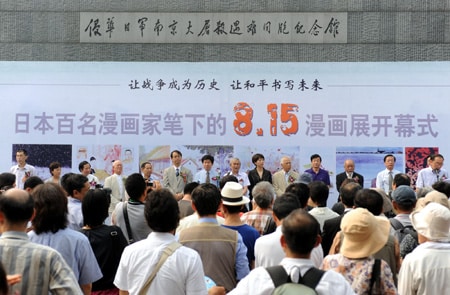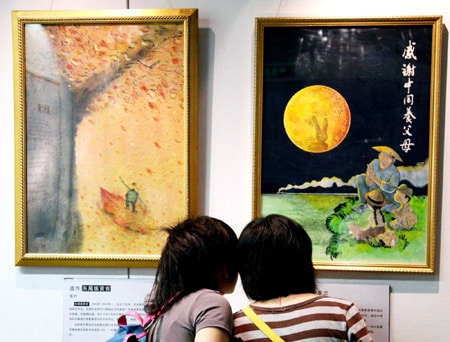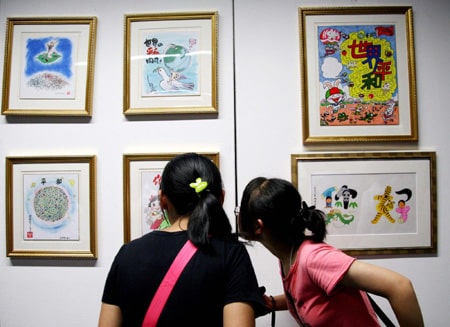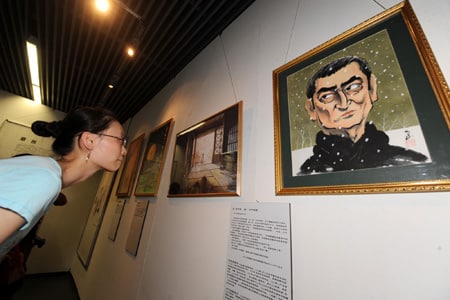With the world economy’s center of gravity shifting from the West to the East, led by China’s rising economic and corresponding political power, the year 2010 may witness a series of epoch-making events in Asia.
日中首脳会談、「友愛」で外交デビュー 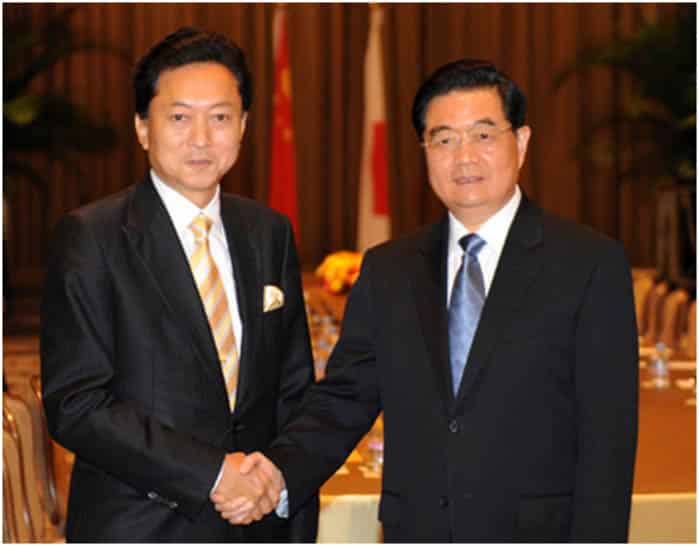 Hatoyama (left) and Hu, 22 September 2009 |
A grand rapprochement between Japan and China could be one such happening. The idea has recently been floated through the media by anonymous diplomatic sources in Tokyo and Beijing, attracting attention among experts worldwide.
The French newspaper Le Figaro reported from Tokyo on January 6 that the Chinese Communist Party (CCP) had delivered to the ruling Democratic Party of Japan (DPJ) the script of a spectacular reconciliation this year between the two countries. The report said that China had proposed that Japanese Prime Minister Hatoyama Yukio begin the process by going to Nanjing, where a mass killing of Chinese civilians by the Japanese Imperial Army took place in December 1937 and subsequently.
This first visit to Nanjing by a Japanese prime minister since the war would present to the Chinese people Tokyo’s official apologies without ambiguity, easing lingering anti-Japanese sentiment among the Chinese public that many associate with unresolved conflicts over the war that ended more than six decades ago. In return, some months later, on August 15, the anniversary of the Japanese surrender in 1945, Chinese President Hu Jintao would go to Hiroshima, the first city to experience atomic bombing, and declare the three non-nuclear principles: China will not make a nuclear first strike, will not attack any non-nuclear country, and will not export nuclear arms. The French paper named as its source only “our information.”
Meanwhile, the Yomiuri, Japan’s largest daily newspaper, also reported from Beijing on January 6 that China had unofficially sounded out Japanese government sources on a visit by Hatoyama to Nanjing, likely around the time he goes to the Shanghai Expo’s Japan Day on June 12, with Hu visiting Hiroshima around the time of the November Asia-Pacific Economic Cooperation (APEC) summit to be held in Yokohama. The Japanese paper said reciprocal visits would aim at improving feelings between the two peoples. Still, unlike Le Figaro, the Yomiuri mentioned nothing about apologies or nuclear promises. It cited “several Japanese and Chinese sources.”
China’s Foreign Ministry denied the Yomiuri report on January 7, with ministry spokeswoman Jiang Yu saying the media rumors of a Nanjing trip were “groundless.” But she also said, in what sounded like a non-denial-denial, “It is too early to confirm the details.” On the same day, Japan’s chief cabinet secretary, Hirano Hirofumi, also denied the reports, saying “at this point, we are not considering” a visit by Hatoyama to Nanjing.
“I have not heard of any such plan,” a top Japanese Foreign Ministry official told Asia Times Online, speaking on condition of anonymity. “My guess is that some persons involved might have presented their wish list to have better relations. There is nothing concrete about it.” This official’s comment suggests that such talks are still going on either at lower government-to-government levels or through party-to-party channels.
The reports by Le Figaro and the Yomiuri followed a similar report in November by the Japanese business magazine, Weekly Toyo Keizai. It reported a secret diplomatic schedule being prepared by relevant Chinese and Japanese players. It predicted that the visit to Beijing one month later by Ozawa Ichiro, secretary general of the DPJ, accompanying more than 600 people, including 143 DPJ lawmakers from the upper and lower houses of the Diet (parliament), would be the first of several Japan-China exchanges. The visit was conducted as part of regular exchanges between the DPJ and the CCP, whose general secretary is Hu.
Chinese Vice President Xi Jinping, who is widely seen as the frontrunner to succeed now President Hu in the fall of 2012, visited Emperor Akihito on December 15 last year. This was the Japanese emperor’s first audience with a Chinese vice president since April 1998, when Hu visited Japan as vice president.
A day earlier at a banquet welcoming Xi, Hatoyama heaped praise on the Chinese guest as a man who is certain to become the country’s leader.
Xi’s meeting with the emperor, however, stirred up controversy in Tokyo, as the Hatoyama administration had arranged it in breach of Imperial protocol which requires that a foreign government’s request for an imperial audience be submitted at least one month in advance; China’s request for the audience was filed in late November — less than one month before the actual audience.
The Imperial Household Agency had strictly requested this protocol, especially after the emperor underwent surgery to treat prostate cancer in 2003, making his health the top priority of the agency.
Under these circumstances the audience highlighted the degree to which the Hatoyama administration is striving to improve Tokyo’s ties with Beijing.
The media reports by Le Figaro and the Yomiuri have triggered strong reactions. After Le Figaro’s report, China’s Global Times posted a questionnaire about possible Japan-China grand rapprochement on its Chinese-language website to which more than 30,000 Internet users responded.
When asked whether the Japanese leader should apologize at the Nanjing Massacre Memorial Museum, 95.0% said “yes.” Only 1% said “no.” When asked whether the Japanese leader’s apology would lead to Japan-China reconciliation, 24.7% said “yes” and 29.5% said “no.” However, when asked whether the Japanese leader could apologize in Nanjing, 17.1% said “yes” and 30.9% said “no.” The remaining 52% offered no opinion (yes and no).
Japanese leaders’ visits to this memorial are nothing new. Nonaka Hiromu, then acting secretary general of the Liberal Democratic Party, visited the memorial on May 9, 1998, laying flowers at the site and becoming the first leader from his party to do so. In the same month, former Japanese prime minister Murayama Tomiichi visited the site. However, no incumbent prime minister has visited the memorial.
Even if speculation over Hatoyama’s visit to Nanjing and Hu’s visit to Hiroshima turns out to be just that, it is still intriguing, as a possible indication of China-Japan rapprochement at a time when US-Japan relations are experiencing strains related to US plans to build a new base at Henoko on Okinawa in the face of deep-seated Okinawan opposition.
At the grass-roots level, there have been indications of easing of tensions centered on the war and war memory. From August 15 to November 15 last year, Japanese manga artists held an exhibition at the Nanjing Massacre Memorial Museum titled “My August 15.” This exhibition displayed 130 drawings depicting Japanese war experiences and condemning war atrocities and reflecting on militaristic brutality, but also showing the Japanese people as victims of war, including settlers in Manchuria and residents of Japanese cities destroyed by bombing. On the opening day of August 15, 2009, the 64th anniversary of the end of the war, some 20,000 people crowded the museum. It had taken seven years to arrange the exhibit in Nanjing on the theme of “My August 15,” the exhibit having been displayed in Japan in 2002.
For China, Nanjing is a microcosm of Japan’s brutal colonial occupation. China’s Nanjing Massacre Memorial Museum and some scholars say that as many as 300,000 civilians, non-combatants, and surrendered soldiers were killed by Japanese troops from December 1937 through January-February 1938; at least 20,000 women were raped. Recent research by Japanese scholars, while recognizing that a major massacre occurred prior to and during the capture of the city, has estimated the deaths in the range of tens of thousands to more than 100,000. Although Japan has recognized that the mass killing of ordinary Chinese took place, calling it either the Nanjing Incident or the Nanjing Massacre, the number of dead has remained a point of contention between the two nations.
For Japan, Hiroshima is a crucial legacy of the Second World War. The United States dropped atomic bombs on Hiroshima on August 6, 1945, and Nagasaki three days later, on August 9. Approximately 140,000 people in Hiroshima and over 70,000 in Nagasaki were killed in a blink of an eye. In a Japanese census of 1950, 284,000 people reported having been exposed to radiation from atomic bombs in the two cities. The mayors and citizens of both cities have since appealed for recognition of the cruelty of the atomic bombs and elimination of nuclear weapons worldwide.
Since 1996, when then-prime minister Abe Shinzo chose Beijing for his first overseas visit, China seems to have refrained from using the historic Japan card to mobilize its own people and pressure Japanese leaders. Historically, the CCP has drawn legitimation from its struggle against the Japanese invader.
Why then might China want Hatoyama to visit Nanjing? There are conflicting views among Japanese experts. Some say that in preparation for a succession of power in 2012 and beyond, Beijing’s internal political battles are intensifying. They note that a faction associated with ex-president Jiang Zemin, who irritated Japanese leaders by bringing up the history issue during a dinner banquet at the Imperial Palace with the emperor in November 1998, has been gaining ground recently. Many Japanese experts believe that Xi has the backing of Jiang, for whom he served as first vice premier, as well as the backing of the so-called princelings in the party, the children of high-level officials born to the party elite whose power extends across the party and business.
Others believe that Beijing wants to settle the historic issues once and for all, to enable the two nations, whose economies are so deeply intertwined, to build a future-oriented relationship of mutual trust, much like the Franco-German reconciliation that president Charles de Gaulle of France and West German chancellor Konrad Adenauer launched by signing the Elysée Treaty in 1963. The foundation of Franco-German cooperation has since been at the center of European integration.
Some US officials and experts may be displeased to see Tokyo’s approach to Beijing at a time of conflict in US-Japan relations.
In a commentary titled “Japan’s Risky Rapprochement with China” published on December 21 by The Wall Street Journal, Kelly Currie, a non-resident fellow of the Project 2049 Institute, a Washington think-tank, wrote:
Prime Minister Hatoyama will likely continue his promised efforts to “rebalance” Japanese relations with the US and China, but now that he’s actually responsible for governing, Mr Hatoyama needs to ask himself: Which country would ultimately keep the Japanese people’s best interests at heart — democratic America or authoritarian China? If the prime minister answers the latter, then the Japanese public — and the Obama administration — really will need to start worrying.
Relations between Japan and China have been rapidly improving since Hatoyama’s China-friendly administration was inaugurated last September, as have relations between Beijing and Taipei since the mainland-friendly administration of President Ma Ying-jeou took office in Taiwan in May 2008. With China looming ever more important in the regional and world calculus, it is not surprising that the US administration of Barack Obama has followed suit.
Every country, driven by economic and political pragmatism, is rushing to come to terms with Asia’s and the world’s rising power. Japan is no exception. The result is the opening of a new and unsettled period in Japan-China-US trilateral relations, whose impact will be felt across East Asia, the Asia-Pacific, and the world.
Kosuke Takahashi is a Tokyo-based journalist. Besides Asia Times Online, he is Tokyo correspondent for Jane’s Defence. He can be contacted at [email protected]. This is a revised and expanded version of an article that appeared at Asia Times Online, which was first published in The Asia-Pacific Journal(18 January 2010); it is reproduced here with the Asia-Pacific Journal‘s permission. See, also, related articles in The Asia-Pacific Journal: Fujiwara Akira, “The Nanking Atrocity: An Interpretive Overview”; Jeff Kingston, “Nanjing’s Massacre Memorial: Renovating War Memory in Nanjing and Tokyo”; Kirk A. Denton, “Heroic Resistance and Victims of Atrocity: Negotiating the Memory of Japanese Imperialism in Chinese Museums”; Daniel Ellsberg, “Building a Better Bomb: Reflections on the Atomic Bomb, the Hydrogen Bomb, and the Neutron Bomb”; Nakazawa Keiji, “Barefoot Gen, the Atomic Bomb and I: The Hiroshima Legacy”; Mark Selden, “Living With the Bomb: The Atomic Bomb in Japanese Consciousness.”
|
| Print

